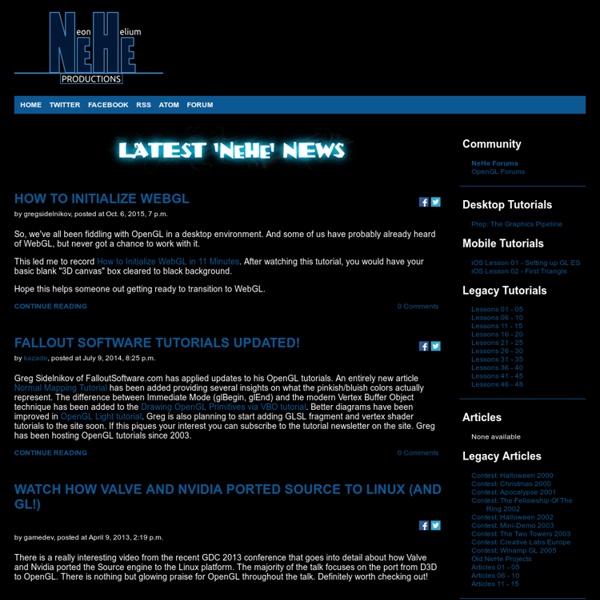Flash ActionScript 3 Tutorials - Beginners
ActionScript is a programming language used to develop applications that will run on the Adobe Flash Player platform. In this page, you'll find a list of beginner's level ActionScript 3 tutorials that will help you understand how to use the ActionScript 3 language to add interactivity to your Flash movies. If you're a Flash designer or animator who is looking to expand your skills in Flash by learning ActionScript 3, I encourage you to browse through these articles, and hope that you will learn a few new things. The lessons are grouped into different categories, which include topics such as Flash AS3 Event Handling, Working with Sound in AS3, and Creating ActionScript 3 Preloaders to name a few.
Graphics for Games; Game; Newcastle University
You are here: Newcastle University » Game » Masters Degree » Graphics for Games Skip to Content Newcastle University Game
.NET Framework 3.5 Service pack 1 (full package)
Microsoft .NET Framework 3.5 service pack 1 is a cumulative update that contains many new features building incrementally upon .NET Framework 2.0, 3.0, 3.5, and includes .NET Framework 2.0 service pack 2 and .NET Framework 3.0 service pack 2 cumulative updates. .NET Framework version 3.5 Service Pack 1 provides the following new features and improvements: ASP.NET Dynamic Data, which provides a rich scaffolding framework that allows rapid data driven development without writing code, and a new addition to ASP.NET AJAX that provides support for managing browser history (back button support). 01Microsoft .NET Framework 4 (Web Installer)The Microsoft .NET Framework 4 web installer package downloads and installs the .NET Framework components required to run on the target machine architecture and OS. Loading your results, please wait...
GPU Gems 3: Chapter 7. Point-Based Visualization of Metaballs on a GPU
The tools, samples and other resources presented here are no longer under active development or support. While we continue to make them available to developers we do not recommend using them in new projects because future hardware features may not be supported. Sample Code NVIDIA Graphics SDK 11 This collection of DirectX 11 code samples is older than the GameWorks Samples.
Creating a Full Flash Site
Creating a Full Flash Site by kirupa chinnathambi Ah yes! The culmination of ones Flash experience can be seen in a full-Flash site. Needless to say, creating a fully "Flashnetized" site can be a frustrating and tiresome process. While this tutorial will not help you design the Flash site, this tutorial will help you to take care of the technical and usability details such as linking between pages, creating a good navigation, and other common stumbling blocks one will encounter when creating a Full-flash site. Before you begin this tutorial, make sure you are somewhat familiar with the following concepts:
Real-Time Rendering Graphics books Page
Game Engine Architecture, by Jason Gregory, A.K. Peters, July 2009. This book is about just that, how to make a professional-grade game rendering system, from soup to nuts. Eberly's two books are the previous notable works in this area, but are quite different than this new volume. While they focus almost exclusively on algorithms, this book attempts to cover the whole task of developing an engine: what to use for source control, dealing with memory management and in-game profiling, input devices, SIMD, and many other practical topics.
Shaders: ShaderLab & Fixed Function shaders
This tutorial will teach you how you can create your own shaders and make your game look a lot better! Unity is equipped with a powerful shading and material language called ShaderLab. In style it is similar to CgFX and Direct3D Effects (.FX) languages - it describes everything needed to display a Material. Shaders describe properties that are exposed in Unity's Material Inspector and multiple shader implementations (SubShaders) targeted at different graphics hardware capabilities, each describing complete graphics hardware rendering state, fixed function pipeline setup or vertex/fragment programs to use. Vertex and fragment programs are written in the high-level Cg/HLSL programming language.
GPU Gems 3 - Chapter 37. Efficient Random Number Generation and Application Using CUDA
GPU Gems 3 is now available for free online! Please visit our Recent Documents page to see all the latest whitepapers and conference presentations that can help you with your projects. You can also subscribe to our Developer News Feed to get notifications of new material on the site.
ShaderLab syntax: Shader
Shader is the root command of a shader file. Each file must define one (and only one) Shader. It specifies how any objects whose material uses this shader are rendered. Syntax Shader "name" { [Properties] Subshaders [Fallback] } Defines a shader. It will appear in the material inspector listed under name.
Quick and Easy GPU Random Numbers in D3D11 – Nathan Reed's coding blog
In games and graphics one often needs to generate pseudorandom numbers. Needless to say, PRNGs are an extremely well-researched topic; however, the majority of the literature focuses on applications with very exacting quality requirements: cryptography, high-dimensional Monte Carlo simulations, and suchlike. These PRNGs tend to have hundreds of bytes of state and take hundreds of instructions to update.
Shader Reference
Shaders in Unity can be written in one of three different ways: as surface shaders, as vertex and fragment shaders and as fixed function shaders. The shader tutorial can guide you on choosing the right type for your needs.



